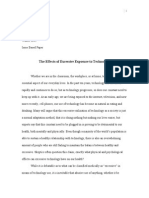0% found this document useful (0 votes)
43 views13 pagesSecond Draft
The document discusses several negative effects of excessive screen time on children including physical issues like neck pain and obesity, as well as mental health issues such as depression, anxiety, eating disorders, and increased risk of suicide. It also examines the impact on social skills and language development.
Uploaded by
api-549790248Copyright
© © All Rights Reserved
We take content rights seriously. If you suspect this is your content, claim it here.
Available Formats
Download as PDF, TXT or read online on Scribd
0% found this document useful (0 votes)
43 views13 pagesSecond Draft
The document discusses several negative effects of excessive screen time on children including physical issues like neck pain and obesity, as well as mental health issues such as depression, anxiety, eating disorders, and increased risk of suicide. It also examines the impact on social skills and language development.
Uploaded by
api-549790248Copyright
© © All Rights Reserved
We take content rights seriously. If you suspect this is your content, claim it here.
Available Formats
Download as PDF, TXT or read online on Scribd
/ 13























































































